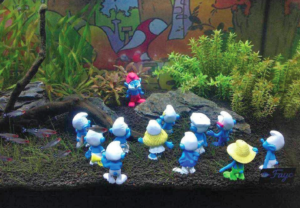Ever since the unexpected yet welcome popularity of the Aquarium Channel on cable TV over two decades ago, more and more Filipinos have chosen to maintain aquariums, and their major reason for doing so for relaxation purposes.
With additional text and editing by Charlene Bobis
They say the sight of a well-maintained aquarium soothes the eye, relieves stress, lowers blood pressure, and unwinds the mind—and these days, the numbers of curated or planted aquariums (also known as ‘aquaria’) are on the rise.

One such creator of planted aquariums is Derrick Pascual, who has been in the hobby for over three decades, since he was five years old. Currently president of the Society of the Philippine Aquarists (SPA) and founding president of Friends In The Same Hobby (FISH), Pascual has won several awards in various local tropical fish competitions.
As a boy, he loved to keep live bearers in small tanks without aerators. The only source of oxygen he put in his tanks were floating aquatic plants, decorated to his liking. He still creates this kind of setup for his live bearers today. Inspired by Takashi Amano, father of the nature aquarium, Pascual decided that he would make it his mission to make aquaria more beautiful, “…(to) put some themes into (them) to make (them) more appealing to kids and to the young at heart.”

While his themed aquariums cost him a minimum of Php15,000 to build, depending on the size, fellow hobbyists will recognize a relative bargain, since the lights, plants, soil, and theme characters, background, and design are already included in the price. Because he draws inspiration from Amano, a majority of his creations are nature aquariums, and Pascual uses real plants and soil that can last for years and even remove the need for filters.
He still creates aquariums with filters, though, for clients who ask for it. He considers himself to be a child at heart, and so Pascual decided to play with the idea of integrating cartoon characters with his passion for the mini-aquatic world. As he used to work with kids, Pascual was dismayed to discover that more and more of them simply didn’t care about nature anymore. He finds that kids today are engrossed in video games and so he thought of incorporating video games and cartoon characters with nature aquariums to make these more appealing to children.

“I was really inspired (by) Amano’s works, and after seeing (the) SpongeBob (Squarepants movie), I thought, why not incorporate the two?! It’s fun, because of the toys inside, yet still calming because of the (fish) and the aquatic (surroundings),” he said. As a result, Pascual now creates and sells themed aquariums. Some of his creations include “Aquatic Plants Vs. Zombies,” “Smurf Happy Fathers’ Day,” “Frozen Aquatic Life,” and “SpongeBob Aqua World.”
Illustrating the Cycles of Life
But it’s not just about whimsy, entertainment, and relaxation; Pascual shared that his themed aquariums are also meant to educate. “These aquariums are (ideal) for school kids. It’s a perfect project for (science subjects) since (these help illustrate the relationship between) oxygen and carbon dioxide…the plant excretes oxygen which is needed by the fish, and the fish (creates the) carbon dioxide that is needed by the plant,” he explained, adding “It also shows how the fish’s stool decomposes and becomes food for the plants.”
Moreover, he said that Math is applied in taking care of aquariums. There are correct ratios for water, soil, the number of plants to fish, how long to keep the aquarium light on, the percentage for water changes, and even in the amount of fish food to feed your charges (in maintaining the aquarium; there are also correct ratios for when one designs a themed aquarium, feeds the fish, and even cleans) it,” he explained.

Letting a child design a themed aquarium teaches the child how to properly care for other living beings, and even bring out their artistic side. Pascual believes that they learn to be more responsible in a happy and fun way, since they have to clean the aquarium, change the water, feed fish, and rearrange the toys inside it—just like playing with them.
Many parents of the children owning Pascual’s themed aquarium say that their children have became more responsible, and have begun to understand that the fish in their tanks depend on them for survival. In the process, they learn about biological mutualism in the interdependent relationship between plants and fish: the fish need the oxygen the plants produce, while the plants need the carbon dioxide the fish produce. They also learn that plants need light to produce their food, and that the feces of fish are a good source of fertilizer for plants.
They can, under the supervision of a responsible adult with a scientific background, even perform experiments. For example, Pascual suggests that they find out what will happen if they overpopulate or underpopulate their tanks with fish. If parents don’t want to be responsible for any fish illnesses or deaths, then they can let their kids experiment instead on what will happen if they keep the light on in their aquariums for longer or shorter times. They can also attempt to find a solution to the problem of “algae bloom.”
“Having these themed aquariums will make mini-scientists out of them; they can do different experiments with their aquariums, without taking away the joy of being kids,” Pascual concluded.
This appeared in Animal Scene’s March 2016 issue.






